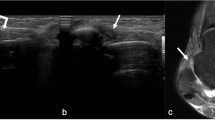Abstract
Objectives
This study evaluates whether the recently described lateral mortise (LM) approach to therapeutic ankle injections can also be used to inject the ankle prior to magnetic resonance arthrography (MRA) without impairing the evaluation of the anterior talofibular ligament (ATFL).
Materials and methods
An IRB-approved, retrospective review of ankle MRAs performed using the LM approach between April 2009 and April 2011 was conducted. The MRAs were independently evaluated by three musculoskeletal radiologists for: ATFL assessment (well assessed, limited or unable to assess), amount of fluid in the anterolateral soft tissues (none to large), and capsular distention (underdistended to overdistended). Patient age, gender, fluoroscopy time, injection location, degree of ankle arthritis, and ankle joint narrowing on radiographs were recorded. Statistical analysis was performed using exact binomial confidence limits.
Results
Fifteen MRAs were successfully performed on 13 patients (mean age: 27 years, 11 male, 2 female). Mean fluoroscopic time was 39 s (range 9–108) and mean volume injected was 7 mL (range 5–9 mL). The ATFL was well assessed on all MRAs. A moderate to large amount of fluid was noted in the anterolateral soft tissues on 5 out of 15 MRAs. No ankle joints were underdistended, but 3 out of 15 were overdistended.
Conclusion
Since the ATFL is inferior to the location used for the LM injection, the interpretation of the ankle MRA, specifically ATFL evaluation, was not compromised in any patient. Therefore, the LM approach can be used as an alternative to the anteromedial approach for ankle MRA without sacrificing diagnostic quality.






Similar content being viewed by others
References
Helgason JW, Chandnani VP. Magnetic resonance imaging arthrography of the ankle. Top Magn Reson Imaging. 1998;9:286–94.
Haage H. Die Arthrographie des Sprunggelenkes. Radiologe. 1967;7(5):137–42.
Ala-Ketola L, Puranen J, Koivisto E, Puupera M. Arthrography in the diagnosis of ligament injuries and classification of ankle injuries. Radiology. 1977;125:63–8.
Chandnani VP, Harper MT, Ficke JR, et al. Chronic ankle instability: evaluation with MR arthrography, MR imaging, and stress radiography. Radiology. 1994;192:189–94.
Spiegel PK, Staples OS. Arthrography of the ankle joint: problems in diagnosis of acute lateral ligament injuries. Radiology. 1975;114:587–90.
Steinbach LS, Palmer WE, Schweitzer ME. Special focus session: MR arthrography. Radiographics. 2002;22:1223–46.
Schmid MR, Pfirrmann CW, Hodler J, Vienne P, Zanetti M. Cartilage lesions in the ankle joint: comparison of MR arthrography and CT arthrography. Skeletal Radiol. 2003;32:259–65.
Fox MG, Wright PR, Alford B, Patrie JT, Anderson MW. The lateral mortise approach for therapeutic ankle injections: an alternative to the anteromedial approach. AJR Am J Roentgenol. 2013;200(5):1096–100.
Hodler J. Technical errors in MR arthrography. Skeletal Radiol. 2008;37:9–18.
Moon J, Shim J, Suh J, Lee W. Radiographic predictability of cartilage damage in medial ankle osteoarthritis. Clin Orthop Relat Res. 2010;468:2188–97.
Kellgren JH, Lawrence JS. Radiological assessment of osteoarthrosis. Ann Rheum Dis. 1957;16:494–502.
Koivikko MP, Koskinen SK. Is subcutaneous local anesthesia in shoulder magnetic resonance arthrography necessary? Acta Radiol. 2007;48(7):741–3.
Shortt CP, Morrison WB, Roberts CC, Deely DM, Gopez AG, Zoga AC. Shoulder, hip, and knee arthrography needle placement using fluoroscopic guidance: practice patterns of musculoskeletal radiologists in North America. Skeletal Radiol. 2009;38:377–85.
Depelteau H, Bureau N, Cardinal E, Aubin B, Brassard P. Arthrography of the shoulder: a simple fluoroscopically guided approach for targeting the rotator cuff interval. AJR Am J Roentgenol. 2004;182:329–32.
Catalano O, Manfredi R, Vanzulli A, Tomei E, Napolitano M, Esposito A, et al. MR arthrography of the glenohumeral joint: modified posterior approach without imaging guidance. Radiology. 2007;242:550–4.
Lohman M, Borrero C, Casagranda B, Rafiee B, Towers J. The posterior transtriceps approach for elbow arthrography: a forgotten technique? Skeletal Radiol. 2009;38:513–6.
Conflict of interests
No grants or conflict of interests to disclose.
Author information
Authors and Affiliations
Corresponding author
Rights and permissions
About this article
Cite this article
Wright, P.R., Fox, M.G., Alford, B. et al. An alternative injection technique for performing MR ankle arthrography: the lateral mortise approach. Skeletal Radiol 43, 27–33 (2014). https://doi.org/10.1007/s00256-013-1740-2
Received:
Revised:
Accepted:
Published:
Issue Date:
DOI: https://doi.org/10.1007/s00256-013-1740-2




